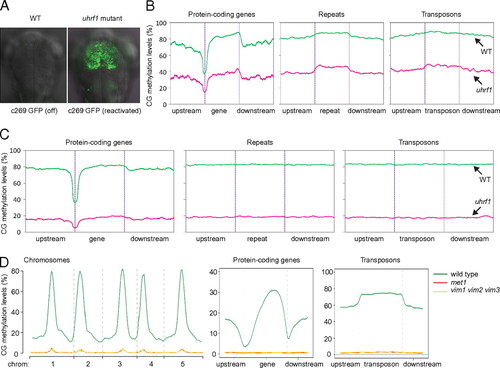- Title
-
Conservation and divergence of methylation patterning in plants and animals
- Authors
- Feng, S., Cokus, S.J., Zhang, X., Chen, P.Y., Bostick, M., Goll, M.G., Hetzel, J., Jain, J., Strauss, S.H., Halpern, M.E., Ukomadu, C., Sadler, K.C., Pradhan, S., Pellegrini, M., and Jacobsen, S.E.
- Source
- Full text @ Proc. Natl. Acad. Sci. USA
|
Decrease of CG methylation in mutants lacking Uhrf1. (A) Reactivation of a transcriptionally silenced transgene in zebrafish uhrf1 homozygous mutants. WT larvae (3 days postfertilization) carrying the silenced allele of the brain-specific transgene Gt(Gal4-VP16;UAS:EGFP) c269 GFP (off) do not show any GFP labeled cells in the brain (Left) due to methylation of CG sites in the multicopy UAS (33). On the contrary, GFP labeled cells resulting from reactivation of the silenced c269 transgene are readily detected in the brains of uhrf1 homozygous mutant larvae (Right). (B–D) Comparison of CG methylation levels between wild-type and uhrf1 mutant lines from zebrafish (B), mouse (C), and Arabidopsis (D). For Arabidopsis, met1 mutant is used as a control for virtual total loss of CG methylation. Tissues used are mouse embryonic stem cells, Arabidopsis flowers, and zebrafish embryos. EXPRESSION / LABELING:
PHENOTYPE:
|

